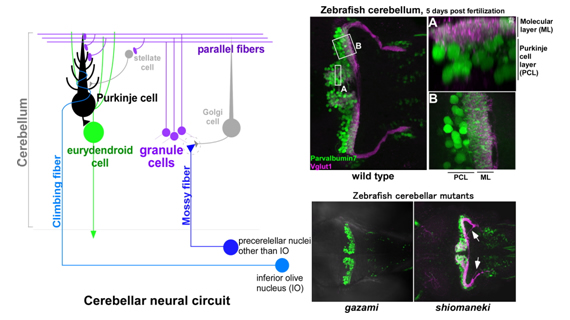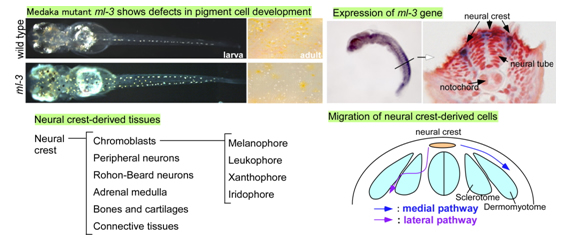Research
Research
During early vertebrate development, the embryonic axes- dorso-ventral (DV), anterior-posterior (AP), and left-right (LR) – are established through a series of inductive signals that are followed by the concerted cell movements and differentiation of a group of cells. Our general interest is in learning how these body axes are established and how cells adopt their fates at the appropriate positions within these axes.
Axis formation
The dorsal organizer plays a major role in the process of axis formation. In amphibian and teleost fish embryogenesis, the program for dorsal organizer formation begins soon after fertilization. In these species, the dorsal determinants are initially localized to the vegetal pole, and subsequently transported to the dorsal side of the embryo. Although the molecular nature of the dorsal determinants has not been elucidated, the dorsal determinants activate the canonical Wnt pathway and thereby lead to the expression of the genes involved in the induction of the dorsal organizer. The dorsal organizer generates secreted signaling molecules that participate in the generation of the DV axis in the mesoderm and endoderm, as well as the formation of the neuroectoderm. Our research aims include elucidation of the mechanisms by which the dorsal organizer is established and regulates axis formation. To address these questions, we are seeking the molecular identity of the dorsal determinants, and trying to identify novel molecules that are involved in the formation and function of the dorsal organizer.【Topics】

Axis formation in zebrafish
Development of the nervous system
We study development of the nervous system as a model of the cell-fate determination that is linked to axis formation. Vertebrate neural tissues are generated through a series of steps. These steps include neural induction, AP patterning, and neurogenesis. In amphibian and teleost species, the neuroectoderm is initially induced by signals from the dorsal organizer. The induced neuroectoderm is characteristically anterior and is subjected to posteriorization during gastrulation. The posterior neuroectoderm is specified by posteriorizing signals emanating from the non-axial mesoderm. Accordingly, the central nervous system becomes highly ordered along the AP axis, with regionalization of the forebrain, midbrain, hindbrain, and spinal cord in a head-to-tail direction. We have been studying the mechanisms that control this neural patterning and determination of local cell fates during neurogenesis. We now focus on development and function of the cerebellum.
The cerebellum functions in the control of smooth and skillful movements. It is also implicated in a variety of cognitive and emotional functions. The cerebellum integrates sensory and predictive inputs, which include proprioception and information associated with motor commands, to elicit precise motor control and higher cognitive/emotional functions. Because the structure of the cerebellum is conserved between teleosts (fish) and mammals, we believe the fish cerebellum to be a good system for studying all the steps involved in cerebellar neurogenesis and the formation of the neural circuitry, with the strong expectation that the findings will be applicable to mammals. We have determined the cell types and neural tracts in the zebrafish cerebellum using molecular markers and transgenic lines. We have also isolated mutations affecting cerebellar neuronal development and the formation of neural tracts. Using genetics and in vivo imaging, we hope to reveal the molecular mechanisms that control the development and maintenance of cerebellar neurons, and the neural circuits in the zebrafish and medaka cerebellum, which will serve as a model system for understanding vertebrate higher brain structure and function. 【Topics】

Differentiation of neural crest
The body color of vertebrate species depends on presence of pigment cells, which are derived from the neural crest. There are four types of pigment cells in medaka. These pigment cells are though to develop from chromoblasts that are the common pigment cell progenitors derived from the neural crest. We believe that the pigment cell differentiation is a good system for understanding how different types of cells are generated from the same progenitors. We are investigating the molecular mechanisms that control the pigment cell differentiation using medaka mutants that have been developed in Nagoya University








